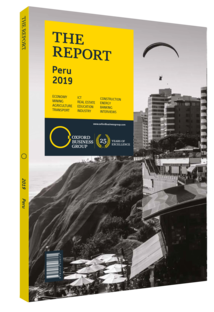Guido Valdivia, Executive Director, Peruvian Chamber of Construction (Cámara Peruana de la Construcción, CAPECO): Interview

Interview: Guido Valdivia
What are some of the challenges Peru faces in securing sufficient investment for infrastructure?
GUIDO VALDIVIA: Peru operates in a difficult climate for public investment in infrastructure. In previous years the government implemented fiscal stimulus measures that allowed a significant number of infrastructure projects to start or be completed until 2018. While public investment did not meet the target of 12.5% of GDP that year, it hit 8.5%, which was above the average seen over the last decade. This stimulus spending was halted in 2019, however, and government spending on public infrastructure is expected to measure in at 2.8% of GDP for 2019, as state authorities have announced lower expenditure figures. This drop in investment will inevitably have an effect on the state of the country’s infrastructure development, especially with regards to the rail, road and air projects that are currently in the pipeline or under consideration.
Peru’s public investment programme has structural flaws that limit the amount of public investment available for infrastructure projects, especially large-scale projects. An example of this is the public tendering law, which, while it has gone through multiple iterations of reform, does not tackle the structural challenges inherent in how public tenders are executed in this country. Added to the structural challenges was a new president who assumed office in early 2018 and his new Cabinet, both of which faced a steep learning curve. Significant changes to the regulatory framework were also introduced in the last months of 2018, making the transition period more complicated.
What role does the private sector play in the residential real estate segment?
VALDIVIA: While housing shortages affect the whole country, they are most prominent in Lima, where more than one-third of the total population is concentrated. One can think of the shortages, however, as a market-led, demand-offer issue. Peru’s housing policy changed significantly in 2002 from one that saw the state involved in all stages of the building process, and one that was directly linked to tenants and buyers, to a policy that sees the state focused on the regulation, facilitation and supervision of both housing projects developed by private companies and mortgage loans granted by private and state institutions.
CAPECO’s market analysis estimates that the current housing demand in Lima is growing by around 125,000 houses per year. New home developments reached a peak of 22,000 units per year between 2011 and 2013, which marks an improvement from previous years, but is still below what is needed in the market. In 2018 only 15,000 units were sold, which created a situation where a significant portion of potential buyers were without a product to purchase, not only in the capital – where the problem is most acute – but also in secondary cities across the country such as Arequipa, Trujillo, Chiclayo and Piura.
How can public works offering and tendering processes be improved to bolster transparency and reduce instances of corruption?
VALDIVIA: Corruption stems from a weak or corrupt civil servant; a company willing to engage in bribery; a legal framework permeable to graft; and inadequate supervision. There are steps Peru can take to address the problem, starting with the establishment of well-structured, efficient and transparent selection and criteria processes. A better functioning public finance management system should be created to ensure that regulators can quickly identify the mismanagement of public funds. A strengthened judiciary is also needed to ease the overwhelming workload of prosecutors. Lastly, the government should reconsider the open-ended statute of limitations for corruption charges, as it has prevented projects being executed because authorities are very unwilling to sign contracts that may cause legal issues in the future.
You have reached the limit of premium articles you can view for free.
Choose from the options below to purchase print or digital editions of our Reports. You can also purchase a website subscription giving you unlimited access to all of our Reports online for 12 months.
If you have already purchased this Report or have a website subscription, please login to continue.

